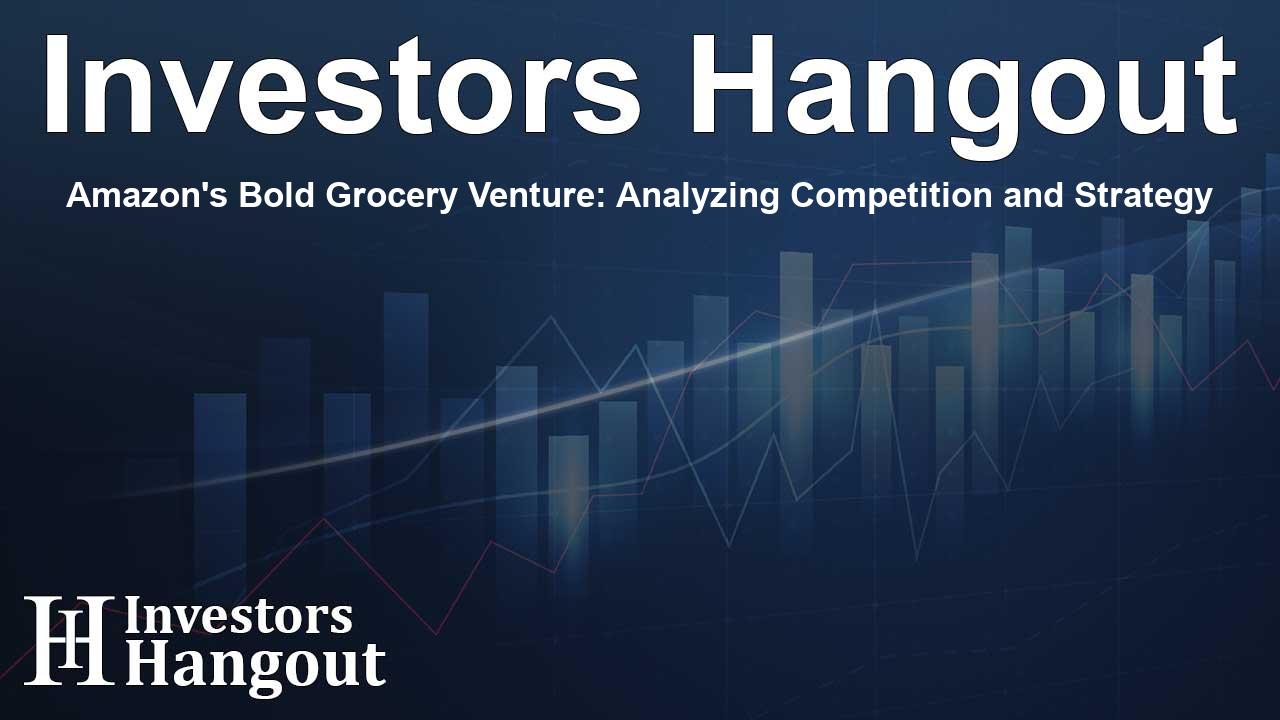Amazon's Bold Grocery Venture: Analyzing Competition and Strategy

Amazon Shows Commitment to Grocery Delivery Expansion
Amazon.com Inc (NASDAQ:AMZN) shares saw a rise of 2.04%, settling at $229.12, which can be attributed to an exciting announcement regarding the expansion of its same-day grocery delivery service. This move is intended to establish a stronger foothold in the grocery market, competing directly with major players like Walmart+ and Instacart.
The tech powerhouse has initiated its grocery delivery service in over 1,000 cities across the U.S. and plans to significantly increase its reach to 2,300 locations before the year's end. This strategic expansion is aimed at amplifying Amazon's market share in a sector where its presence has been less dominant compared to other retail categories.
Strategies Behind Amazon's Grocery Services
Currently, Amazon's same-day delivery is operational in major urban areas such as Phoenix, Raleigh, and Tampa. In a noteworthy move, the company has committed $4 billion to upgrade delivery services, particularly targeting over 4,000 rural communities. For Amazon Prime members, delivery is complimentary on orders exceeding $25, while non-members incur a fee of $12.99, irrespective of the order size. This competitive pricing directly challenges the existing Walmart+ model, which offers its service at an annual fee of $98, promising deliveries in under three hours—with rapid options arriving in as quickly as 30 minutes.
A significant change in Amazon's pricing strategy saw the removal of a $9.99 monthly fee that Prime subscribers previously incurred for free grocery deliveries through Amazon Fresh and Whole Foods Market on orders above $35. The new, lowered order threshold and omitted fee signify Amazon's dedication to increasing customer engagement. According to industry analyst Blake Droesch, this aggressive expansion stands out as a significant leap for Amazon's digital grocery services, particularly since it is introduced to its vast Prime membership base without any extra charge.
This impactful announcement led to a swift reaction in the stock market, as Amazon's shares gained an additional 1.4%, while competitors like Instacart faced a notable 12.4% reduction in their stock value. Other rivals, including DoorDash and Kroger, experienced declines as investor apprehensions regarding increasing competition in grocery delivery intensified.
Investor Reactions and Market Dynamics
The scrutiny around Amazon's grocery delivery expansion reveals its ambitions to capture substantial market share in a retail area where it previously could not secure dominance. Analysts such as Stephen Ju from UBS remark that this move effectively lowers the barriers for both Prime and non-Prime users interested in purchasing their groceries through Amazon, which could adversely affect the profitability of services like Uber Eats and DoorDash. By allowing customers to purchase perishables, like strawberries and milk, alongside electronics in a combined order, Amazon is taking full advantage of its comprehensive logistics framework.
As Amazon broadens its domestic grocery delivery scope, it encounters hurdles in international markets, particularly in areas like the UK where research highlighted challenges with supplier relations. However, this domestic focus perfectly aligns with the overall trends in the grocery delivery sector, as competitors like Walmart are also ramping up their efforts to provide efficient delivery options across the United States.
Insights from industry leaders, such as Chedly Louis from Moody's Ratings, caution that Amazon's rapid dive into perishable food deliveries threatens small, independent grocers, potentially reshaping the competitive landscape. With a market capitalization of $2.444 trillion and stocks trading at approximately $229.18, Amazon is consistently illustrating its capability to disrupt traditional retail through strategic investments and a competitive pricing model.
This willingness to compromise on short-term profitability in order to achieve a larger market share speaks volumes about Amazon's overarching vision for comprehensive domination across the retail landscape.
Frequently Asked Questions
What is Amazon's recent grocery delivery expansion?
Amazon has expanded its same-day grocery delivery service to over 1,000 cities with plans to reach 2,300 locations by year-end, aiming to compete heavily in the grocery market.
How does the pricing model for Amazon's grocery delivery work?
For Prime members, delivery is free on orders over $25, while non-members pay a $12.99 fee, providing a more attractive option compared to competitors like Walmart+.
What impact did the announcement have on Amazon's stock?
Following the announcement, Amazon's shares rose by 1.4%, while competitors like Instacart saw significant drops in their stock prices.
How is Amazon's expansion affecting independent grocers?
Analysts express concern that Amazon's aggressive push into perishable food delivery may weaken the market position of small, independent grocery stores.
How does Amazon's grocery service compare to Walmart+?
Amazon offers free delivery for Prime members on lower minimum orders, while Walmart+ charges an annual fee for its services, creating direct competition in the grocery delivery sector.
About The Author
Contact Hannah Lewis privately here. Or send an email with ATTN: Hannah Lewis as the subject to contact@investorshangout.com.
About Investors Hangout
Investors Hangout is a leading online stock forum for financial discussion and learning, offering a wide range of free tools and resources. It draws in traders of all levels, who exchange market knowledge, investigate trading tactics, and keep an eye on industry developments in real time. Featuring financial articles, stock message boards, quotes, charts, company profiles, and live news updates. Through cooperative learning and a wealth of informational resources, it helps users from novices creating their first portfolios to experts honing their techniques. Join Investors Hangout today: https://investorshangout.com/
The content of this article is based on factual, publicly available information and does not represent legal, financial, or investment advice. Investors Hangout does not offer financial advice, and the author is not a licensed financial advisor. Consult a qualified advisor before making any financial or investment decisions based on this article. This article should not be considered advice to purchase, sell, or hold any securities or other investments. If any of the material provided here is inaccurate, please contact us for corrections.
